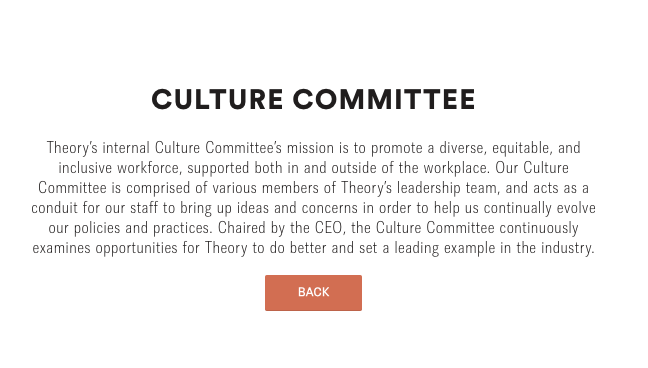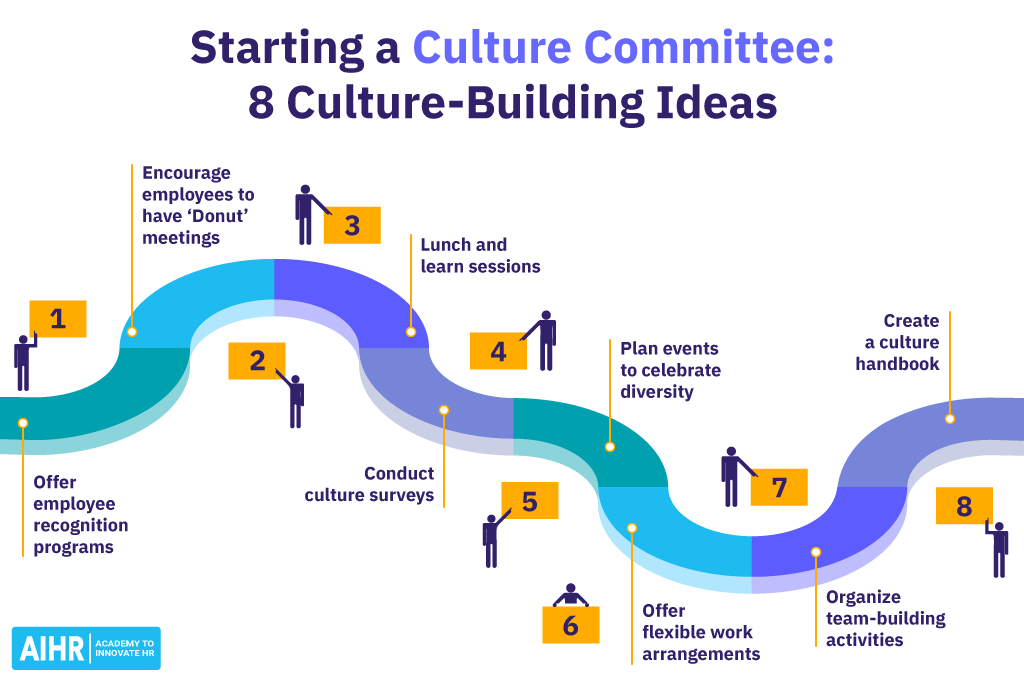What Is a Culture Committee? How To Build Yours in 2024

A culture committee is a dedicated group of employees within a company tasked with cultivating and nurturing its culture. They can help cultivate a thriving work environment where employees feel motivated and engaged to perform their best.
According to Quantum Workplace, employees who perceive their company’s culture as positive are 3.8 times more likely to show high levels of engagement. Also, a significant 84% of employees who view their organizational culture positively report being highly engaged.
Contents
What is a culture committee?
8 culture committee ideas
How HR can help build a culture committee in the workplace
Culture committee mission statement examples
What is a culture committee?
The culture committee acts as a guardian of the company’s values, behaviors, and practices to ensure a positive and engaging workplace environment for all employees. They help HR address or influence some workplace issues, such as:
- Recruitment: Develop interview questions and criteria that evaluate a candidate’s cultural fit.
- Performance management: Design performance review systems that incorporate cultural values and behaviors.
- Compensation and benefits: Advocate for transparent and fair compensation practices to reinforce company values like trust and accountability.
- Rewards: Roll out employee recognition programs highlighting behaviors aligned with the desired culture.
- HR policies: Provide input on company policies that impact employee behavior and company norms.
Culture committees, employee resource groups (ERG), and affinity groups can work together to shape the company culture. However, there are differences in their focus and goals:
| Culture committee | ERG and affinity group | |
|---|---|---|
| Focus | Overall company culture | Specific identity or shared interest |
| Composition | Representatives from across the organization | Open to all interested employees who have shared affinity or allyship |
| Goal | Improve overall organizational culture | Provide support for a specific group or build connections around a shared interest |
| Activities | Concentrate on formal initiatives and policy changes | Emphasizes community building and engagement |
What does a culture committee do?
A culture committee is tasked with promoting a positive work environment:
- They work with the leadership team to define the core values, beliefs, and behaviors that shape the organization’s culture
- They roll out strategies promoting and reinforcing the desired culture, like team building activities, recognition programs, promoting work-life balance, and fostering open communication
- They listen and address any culture-related employee concerns
- They advocate for changes in company culture, such as policy updates, new benefits, or company restructuring, to align with the desired culture
- They track progress toward cultural goals to evaluate their effectiveness or make adjustments when necessary.
The role of HR in a culture committee
Human resources is crucial in providing support and empowerment to the culture committee:
- HR can help identify and recruit members for the culture committee to build a diverse and skilled group
- The culture committee may work closely with HR to implement programs and policies that create an inclusive workplace
- HR professionals often take on leadership roles within the culture committee. They may coordinate committee activities, chair meetings, and ensure the initiatives align with the organization’s HR strategy
- HR also works closely with the culture committee to develop strategies for improving employee satisfaction, motivation, and wellbeing
- The culture committee and HR collaborate to design and implement recognition initiatives celebrating employee contributions and achievements
- HR can offer administrative support, logistical assistance, and access to relevant resources
- HR can train the committee on culture-building practices to prepare committee members for their roles
- HR acts as a bridge between the committee and other departments, fostering collaboration and alignment across the organization.
Why have a culture committee?
Culture committees can help nurture a positive and productive work environment:
Helps make culture more tangible
More than just stating your company values on your website and social media, culture committees can translate these abstract ideas into tangible practices and behaviors that drive the target goals, like customer satisfaction and collaboration.
Address specific challenges
Culture committees help address common challenges like miscommunications, low employee morale, or lack of inclusivity. For example, if the company lacks teamwork, they can propose that HR and management introduce collaboration apps to make working more productive and seamless for hybrid workers.
Champion diversity
Culture committees can champion diversity by advocating for inclusive hiring practices, promoting unconscious bias training, and creating a culture where all individuals feel appreciated and respected.
In a report by Employ, 38% of candidates surveyed said they would turn down a job offer if the company lacked diversity in its workforce or had no clear goals for improving diversity.
Boost employee engagement
Culture committees can boost employee engagement by encouraging everyone to participate in cultural initiatives. Involving employees in shaping the culture through committees, projects, or feedback empowers them and increases their sense of ownership.
Quantum Workplace reported that 57% of employees believe individual contributors are responsible for shaping culture. Individuals must understand and live out their culture, mission, and values to create a strong culture. They must collaborate, recognize, communicate, and behave in a way that aligns with cultural norms.
8 culture committee ideas
There are various ways to promote and celebrate company culture that resonates with all employees. Here are some ideas:
1. Offer employee recognition programs
Culture committees can organize programs to celebrate employee accomplishments. So when an employee demonstrates a behavior or action that exemplifies your company values, recognize and reward them for it.
Recognition programs can be flexible. If there is a surge in company profits this year, you can reward company performers with promotions and bonuses or hold employee appreciation events to award deserving employees. Or you can do it more frequently, like shout-outs for an employee who did well on a particular week.
2. Encourage employees to have ‘Donut’ meetings
Using “Donut” meetings to introduce everyone in the company and break down silos. Doing this makes every employee feel welcome, creating a sense of community within the company.
To make “Donut” effective, set clear expectations like improving communication or collaboration. Allow employees to choose how they want to meet their colleagues: virtual or face-to-face, topics of conversation, and preferred times.
Provide icebreakers to guide the conversation and remove any awkwardness in first-time interactions. You can incorporate them into other cultural initiatives like onboarding, team-building activities, and mentorship programs.
3. Lunch and learn sessions
Lunch and learn meetings are informal and engaging ways to educate employees about your company culture while giving them a break with food and connection. It is doable and cost-effective to implement. Sharing a meal and learning can break down barriers and strengthen employee relationships.
Mix up formats like presentations, discussions, guest speakers, or interactive to make your lunch and learn sessions engaging. Keep it short to avoid disrupting workflow. Conduct sessions at different times to accommodate all employees. Promote it across company communication channels to ensure good attendance.
4. Conduct culture surveys
You wouldn’t know if your culture-building strategies are working unless you ask your staff. Learn what employees think and feel through one-on-one meetings, suggestion boxes, anonymous surveys, and 360-degree review strategies.
Incorporating their suggestions can help HR and the committee understand employees’ preferences so you can introduce culture programs that fit their needs.
5. Plan events to celebrate diversity
Recognizing diversity is the core of an inclusive culture where employees of all backgrounds are heard and respected. Employees feel comfortable stepping forward with their ideas without fearing rejection because of their background.
You can celebrate diversity by acknowledging the different cultures and values of the workforce. Hold events featuring food or traditions from a specific region, highlighting cultural diversity while educating colleagues.
6. Offer flexible work arrangements
A culture that supports work-life balance attracts and retains talent, fosters a positive environment, and promotes employee wellbeing.
Offering flexible work arrangements like remote work, flexible schedules, and hybrid work demonstrates the company’s commitment to employee wellbeing and trust, aligning with values like respect, fairness, and inclusivity.
7. Organize team-building activities
Sometimes, short sessions are not enough to instill company values and culture. That’s where team-building activities are more appropriate. These outside activities allow employees to get to know each other more personally and deeply, which builds trust and camaraderie over time.
There are different team-building activities: volunteer activities to charities, weekend staycations at nearby hotels doing fun activities like singing or swimming, and competitive ones like cookoffs or outdoor group games. Remember to consider your team sizes and personality types when choosing suitable activities. Select activities that promote the desired cultural values. And plan your activities according to your budget and available resources.
8. Create a culture handbook
Writing down your company culture statements and goals indicates that they are essential to the organization and that everyone should know them as early as the first day of work.
In your handbook, describe how your values translate into everyday actions and decisions to set new hires’ expectations. Include employee testimonials and stories that highlight these behaviors. Use visuals to make it enjoyable to read.
HR tip
Distribute the culture handbook during onbaording to effectively communicate the company’s core values and answer any questions new hires might have about it.
How HR can help build a culture committee in the workplace
Step 1: Assess the organization’s needs
Evaluating company and business goals ensures the committee addresses the organization’s cultural needs. You can also factor in current culture initiatives and industry trends so they align with the desired results.
Some of the most common areas culture committee members should focus on include:
- Improving communication
- Boosting employee engagement and recognition
- Enhancing diversity and inclusion
- Promoting work-life balance.
Step 2: Gain leadership support
The committee can plan and implement cultural strategies with management approval and backing. Company leaders will provide adequate budget and resources; their endorsement during town hall meetings and company-wide emails can guarantee employee participation in cultural activities.
Step 3: Develop a culture committee charter
The charter should define the culture committee’s purpose, objectives, and responsibilities. It should also outline the processes involved, like operation, decision-making, and communication policies.
For example, if you implement a culture committee to develop an employee recognition program, list eligibility and selection criteria for employee awardees. Draft a budget for the event plus what type of awards or rewards go for each eligible employee: will they receive a trophy gift certificate or cash incentives?
Step 4: Select committee members and determine their responsibilities
You need to have the right people to ensure the success of cultural initiatives. When choosing individuals, look for employees who genuinely care about your company culture and are willing to invest time and effort in committee activities. Identify employees who are respected by their peers and can champion cultural change within their teams and departments. To avoid biases, have a diverse set of people in your committee from different departments, tenure, levels, ethnicity, gender, and other demographics.
Next, assign responsibilities for each member:
- Chair: Leads the committee and discussions
- Champion: Advocate the importance of culture and its initiatives
- Communications: Implement communication strategies to announce activities
- Events organizer: Execute events that promote company culture
- Data analyst: Measure the effectiveness of initiatives and their impact on the organization.
Step 5: Define the culture committee mission statement
Your culture mission statement will guide your committee members when planning and executing culture programs. Your mission statement should be clear, actionable, and inspiring. Here is an example:
“To champion a collaborative, passionate, and trusting culture where all employees feel valued and empowered to grow. “
We’ve included some examples of culture committee mission statements in the next section for some real-life company inspiration.
HR tip
Involve stakeholders in brainstorming your mission statement to ensure it aligns with the organization’s values and vision, while remaining relevant and adaptable to future changes in your company culture.
Step 6: Establish meeting cadence
Create a meeting schedule and notify members in advance so they can arrange their timetables accordingly. Meetings can be done face-to-face or via Zoom whenever it is convenient for all members. Follow-ups and updates can be communicated via email so things can move forward quickly and regularly.
Step 7: Create a culture committee action plan
When creating your action plan, you need to evaluate your current company culture and your desired objectives. From there, prioritize initiatives to help you reach your cultural goals. Consider the potential impact of each initiative and its alignment with overall goals.
For each initiative, create actionable steps with timelines and responsibilities. Include the budget, personnel, and resources involved. Remember to outline the communication plans to inform employees of the action plan and its progress.
Step 8: Implement feedback mechanisms
Check how employees feel and what they think of the action plan: are they happier or more engaged due to the initiative? Use surveys, suggestion boxes, or other tools to gather insights. Collecting and analyzing sentiments lets the committee know if the strategies are working and what needs to change.
Culture committee mission statement examples
NTT DATA Group
NTT DATA is a global innovator of IT and business services headquartered in Tokyo.
“We come from all different areas of the NTT DATA Business Solutions footprint. We build on trust from our people. We listen, plan and proactively support all that matters for our NTT DATA Business Solutions culture. We strive to bring value to everything we do. We represent NTT DATA Business Solutions’ culture by bringing together our people.”
Some of their culture committee activities include:
- Virtual scavenger hunt games for employees
- Virtual trivia games for employees
- Virtual coloring pages for employees children
- “Who am I” employee guessing games
- “Dinner On Us” employee nomination events
- Post pictures of employees working from home offices
- Leukemia and Lymphoma “Light the Night Walk” companywide virtual charity event
- Virtual Diwali event
- Virtual all employee Holiday party
- Adopt A Family charity event.

Theory Wellness
Theory Wellness ( “TW”) is a leading provider of craft cannabis.
“Theory’s internal Culture Committee’s mission is to promote a diverse, equitable, and inclusive workforce, supported both in and outside of the workplace. Our Culture Committee is comprised of various members of Theory’s leadership team, and acts as a conduit for our staff to bring up ideas and concerns in order to help us continually evolve our policies and practices. Chaired by the CEO, the Culture Committee continuously examines opportunities for Theory to do better and set a leading example in the industry.”

Key takeaway
Company culture is much more than just free lunches or beer every Friday. It binds an organization, fostering employee engagement, productivity, customer experience, and brand reputation.
Building a strong culture is an ongoing process. A committee can help by implementing and promoting culture strategies to encourage active participation from employees and align behaviors and practices with the desired culture.
Weekly update
Stay up-to-date with the latest news, trends, and resources in HR
Learn more
Related articles
Are you ready for the future of HR?
Learn modern and relevant HR skills, online












